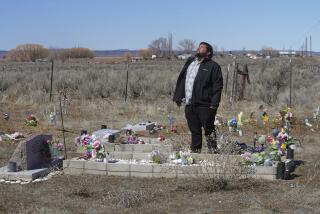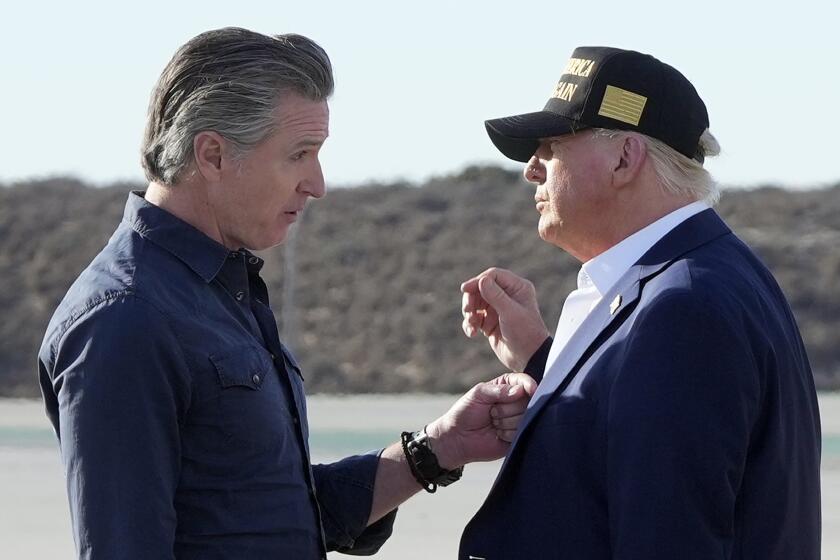A Moving Task for Man With a Vision
- Share via
TUSTIN-Phil Stevens received a vision from God asking him to help impoverished Native American families on the reservations.
Well, sort of.
The vision was actually seven priests who had called him into a meeting at a school in South Dakota, where Stevens was volunteering, to ask him to help Native Americans. But that was enough to convince him to lend a hand.
“There were these seven men of God standing in front of me, and it was hard to ignore the message they were trying to send,” Stevens said.
With his Oglala Sioux heritage and more than 27 years of volunteer work with Native Americans, Stevens started the Tustin-based Walking Shield American Indian Society in 1986 to fulfill his promise to the priests.
The society has grown every year since then. It grew so fast that Stevens, who lives in Newport Beach, decided to sell his lucrative engineering firm in 1988 to focus his full attention on providing free technical assistance and managerial advice to Native Americans. The company, Irvine-based Ultrasystems, had begun as a one-man operation 19 years earlier and had become a multimillion-dollar, publicly held corporation when he sold it.
“It was a tough decision, but I figured that the needs of Native Americans were greater than the needs of my company,” he said.
Bob Goodwin, president of the national Points of Light Foundation, said the “fact that this man stepped from his own plateau of comfort and success to raise resources for these people so that they can have a better life is highly commendable.”
Last year, President Clinton presented Stevens with the Presidential Service Award, the nation’s highest award for volunteer service.
When Stevens started Walking Shield, which is his Indian name, he knew a huge amount of resources would be needed to help the thousands of homeless on the reservations and the tens of thousands who live in substandard houses.
The homes on reservations in the Northern Plains, he said, are among the worst in the nation. According to the 1990 census, almost 60% of the housing there is substandard, he said.
The census also reported that the death rate from tuberculosis is 1,300% higher on reservations than the national average. Deaths from diabetes are 574% higher and the infant mortality rate is 81% higher.
“This is becoming a human tragedy and a national shame,” he said.
*
So Stevens decided to look for support everywhere he could, including organizations, corporations, schools and the military.
Patagonia Inc. and Nordica each agreed to provide thousands of pieces of outdoor clothing and boots. Hasbro Inc. and Mattel Inc. signed on to provide new toys for the children at Christmas. Together with other donations, 20,000 new toys were sent to the reservations last year.
And when the Crystal Cathedral in Garden Grove decided to change all of its 2,300 pews, Stevens was there making sure they weren’t destroyed, but sent to 50 churches on the reservations. Transportation for all the goods was provided free by United Parcel Service.
“We just had to network all these different organizations to find a better life for American Indians,” he said. “They would never have been able to afford those products without their help.”
The society’s largest and most important relief effort comes next month when it coordinates the relocation of more than 400 houses from the U.S. Air Force Base in Grand Forks to 11 reservations in North and South Dakota.
The idea for the project, dubbed Operation Walking Shield, was Stevens’.
He had received a call from a friend who said that because the base was closing, 463 houses were going to be destroyed to make room for new development.
Knowing these three-bedroom, two-bath, 1,200 square-foot houses would be greatly needed on the reservations, he put in a few calls to the base and the senators fromNorth and South Dakota, and they were his.
“They were just going to bulldoze them, so I jumped in there and said, ‘We need these for the reservations,’ ” he said.
Stevens then called the Pentagon and received help from the Air Force in dropping off supplies such as food and clothing to the reservations and installing the foundations for the houses. The Bureau of Reclamation is providing water and electricity hook-ups. The U.S. Department of Housing and Urban Development is paying for all transportation costs, and the Fannie Mae Foundation has made a $50,000 donation to the project. The U.S. Marine Corps is paving 20 to 25 miles of roads that were washed out during the recent flooding.
“These people should have a decent chance at the American dream,” Stevens said. “I’ve been blessed with that opportunity.”
*
Born in Inglewood and raised in East Los Angeles, Stevens has never forgotten his Native American background. His great-grandfather fought in the Battle of the Little Big Horn, he said. (He got the name Stevens after his grandmother married an Englishman.)
His organization, Stevens said, is “not just about talk. Walking Shield has gained the reputation that we can make things happen.”
However, Stevens knows that his job is not close to being done. The society’s 500 volunteers throughout the country have helped about 30 of the 557 tribes in the United States or about 300,000 of the nation’s 2 million Native Americans.
“They have so many connections” said Paul Iron Cloud, the executive director of the Oglala Sioux Housing Authority in South Dakota. “And Phil, he has done so much for his own people.”
More to Read
Sign up for Essential California
The most important California stories and recommendations in your inbox every morning.
You may occasionally receive promotional content from the Los Angeles Times.











